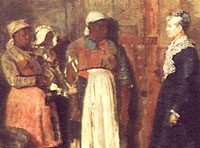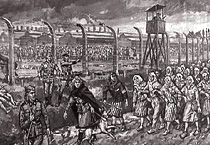War Relocation Authority Camps in Arizona, 1942-1946

Note: Unpublished because annotation does not seem to match website. Larger parent website also already covered at http://teachinghistory.org/history-content/website-reviews/23319.
This exhibit by an art student begins with 11 color postcard-like recreations of original black-and-white photographs documenting life in the Poston (AZ) War Relocation Center, where more than 17,000 Japanese-Americans were interned between 1942 and 1945 by the U.S. military. An accompanying essay provides background information and a brochure describes the Poston Monument. In addition, viewers can access six pages from "an Internment Camp's High School Yearbook," and additional legal documents, memoirs, newspaper and journal articles, a timeline, and book excerpts through links to 26 related documents and 40 websites. An important site on the internment experience.


